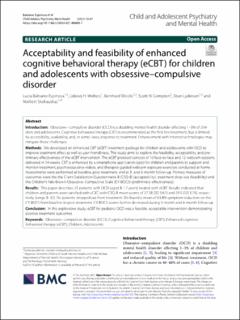| dc.description.abstract | Introduction Obsessive–compulsive disorder (OCD) is a disabling mental health disorder affecting 1–3% of children and adolescents. Cognitive behavioral therapy (CBT) is recommended as the first-line treatment, but is limited by accessibility, availability, and, in some cases, response to treatment. Enhancement with Internet technologies may mitigate these challenges. Methods We developed an enhanced CBT (eCBT) treatment package for children and adolescents with OCD to improve treatment effect as well as user-friendliness. This study aims to explore the feasibility, acceptability, and preliminary effectiveness of the eCBT intervention. The eCBT protocol consists of 10 face-to-face and 12 webcam sessions delivered in 14 weeks. CBT is enhanced by a smartphone application (app) for children and parents to support and monitor treatment, psychoeducative videos, and therapist-guided webcam exposure exercises conducted at home. Assessments were performed at baseline, post-treatment, and at 3- and 6-month follow-up. Primary measures of outcomes were the the Client Satisfaction Questionnaire-8 (CSQ-8) (acceptability), treatment drop-out (feasibility) and the Children’s Yale-Brown Obsessive–Compulsive Scale (CY-BOCS) (preliminary effectiveness). Results This paper describes 25 patients with OCD (aged 8–17 years) treated with eCBT. Results indicated that children and parents were satisfied with eCBT, with CSQ-8 mean scores of 27.58 (SD 0.67) and 29.5 (SD 3.74), respectively (range 8–32). No patients dropped out from treatment. We found a mean of 63.8% symptom reduction on the CY-BOCS from baseline to post-treatment. CY-BOCS scores further decreased during 3-month and 6-month follow-up. Conclusion In this explorative study, eCBT for pediatric OCD was a feasible, acceptable intervention demonstrating positive treatment outcomes. | en_US |

